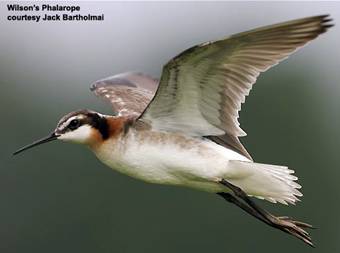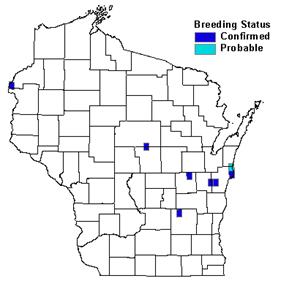

Status/Protection
- Global Rank: G5 Key to global and state ranks
- State Rank: S1B
- WBCI Priority: SGCN, SBIRD, State Special Concern
Population Information
There are currently no broad-scale projects designed to identify population size or monitor changes within shorebird populations (Brown et al. 2001). The North American population estimate is 1.5 million (Morrison et al. 2006).
- WSO Checklist Project: stable (1983-2007)
Life History
- Breeding Range: Primarily British Columbia south to northern California east to the Praire Provinces and Great Plains (Colwell and Jehl 1994).
- Breeding Habitat: Emergent Marsh, Inland Open Water, Northern Sedge Meadow and Marsh, Southern Sedge Meadow and Marsh, and other open wet meadow habitats.
- Nest: Ground, depression in upland or occasionally wetland vegetation (Colwell and Jehl 1994).
- Nesting Dates: Eggs: late May to late June (Robbins 1991).
- Foraging: Surface dips, probes (Ehrlich et al. 1988).
- Migrant Status: Neotropical migrant.
- Habitat use during Migration: Emergent Marsh and other open, shallow water habitats.
- Arrival Dates: Late April to late May (Robbins 1991).
- Departure Dates: Few birds remain beyond 10 September (Robbins 1991).
- Winter Range: Western and southern South America – highlands of Peru, Bolivia, Chile, and Argentina (Colwell and Jehl 1994).
- Winter Habitat: Most commonly found in and near saline and alkaline lakes (Ehrlich et al. 1988).
Habitat Selection
Although there are Wisconsin breeding records for the Wilson’s Phalarope (Robbins 1991, Harriman 2006), the state is not within its core nesting area. Throughout its range, it nests in a variety of habitat types and conditions, including upland and wetland areas containing both sparse and dense vegetation (Colwell and Jehl 1994). In Wisconsin it nests in uncropped fields, agricultural fields, sedge meadows, and other open lowland habitats (Harriman 2006). During migration it prefers open, shallow water habitats, particularly saline and alkaline lakes in the western portion of its range (Colwell and Jehl 1994).
Habitat Availability
Although the Wilson’s Phalarope and other shorebirds are opportunistic and can capitalize on food resources wherever available during migration, the loss of wetlands, tiling and draining of agricultural fields, and conversion of grassland habitats has reduced foraging opportunities in Wisconsin. Prior to Euro-American settlement, wetlands occupied an estimated four million hectares of the total fourteen million hectares of Wisconsin’s land area. Today, 53% (2.1 million hectares) of these wetland habitats remain (WDNR 2003) and conditions at these sites can be extremely variable and highly dependent on precipitation and hydrology patterns (Szalay et al. 2000). Furthermore, exotic species (e.g., purple loosestrife, zebra mussel, carp) and industrial effluents have the potential to reduce invertebrate food resources at these sites (WDNR 2005). The conversion of pastures and other short-grass habitats to row crops also reduces foraging habitat in the state. Of the 850,000 hectares of native prairie present prior to Euro-American settlement, less than 4,000 hectares remain today (WDNR 2005).
Population Concerns
The North American population estimate is 1.5 million with a declining trend suspected (USSCP 2004, Morrison et al. 2006). In general, population trend data are inconclusive because no broad-scale projects currently exist that monitor changes in North American shorebird populations (Brown et al. 2001). Several factors complicate population trend monitoring for the Wilson’s Phalarope, including its use of ephemeral wetland habitats and a lack of information on turnover rates at migratory stopover sites which confounds interpretation of survey data (Brown et al. 2001, Morrison et al. 2001). Limiting factors are unknown (Brown et al. 2001), although ongoing broad-scale habitat alteration and land use changes likely are significant threats (Szalay et al. 2000, Colwell and Jehl 1994).
Recommended Management
Preventing habitat destruction and minimizing factors that compromise the maintenance of invertebrate populations are important management considerations. The continuation of wetland management, protection, and restoration efforts such as the Wetlands Reserve Program, Partners for Fish and Wildlife, and North American Wetland Conservation Act will benefit this and other waterbird species. Wetland restoration efforts should create complexes of seasonal and semipermanent wetlands within areas that will increase overall wetland connectivity (Knapp 2001). Management actions (e.g., disking and flooding, control of invasive wetland plants, periodic, slow drawdown) that create mosaics of mudflats and shallow water areas will provide foraging habitat for Wilson’s Phalarope and other migrant shorebirds (Eldridge 1992). Managed wetland drawdowns should coincide with shorebird migration but should be staggered across units to extend habitat and food resource availability throughout the entire migratory period (Helmers 1992). Partnerships between state and federal agencies and private organizations dedicated to the restoration, conservation, and management of grassland ecosystems also will benefit the long-term management of Wilson’s Phalarope and other grassland-associated species. Conservation and management efforts for this species should be focused in the following Wisconsin ecological landscapes: Central Lake Michigan Coastal, Central Sand Plains, Northwest Sands, and Southeast Glacial Plains (WDNR 2005).
Research Needs
Although research needs for Wilson’s Phalaropes and most other shorebird species are significant, of primary importance is the identification of population limiting factors (Brown et al. 2001). This information is essential to better understand which factors need to be changed to increase shorebird populations. Improved survey methods and an institutional capacity for monitoring shorebirds also are urgently needed (Brown et al. 2001). A state assessment of the distribution, abundance, conditions, and ownership of wetlands and other important shorebird habitats also would further management efforts and guide future restoration projects (Szalay et al. 2000). More information on the dynamics of migration patterns is warranted, including how populations move among sites and why (Brown et al. 2001). In Wisconsin, comparative studies on the feeding ecologies of migrant shorebirds would help determine how coexisting species and their prey react to different wetland management regimes and habitat conditions. Color-banding individuals at stopover sites may help to determine length of stay, refueling capacity, impacts of disturbance, and important habitat features associated with these sites (Davis and Smith 1998, Szalay et al. 2000, Brown et al. 2001). Finally, studies that document Wilson’s Phalarope survivorship and lifetime reproductive success are warranted (Colwell and Jehl 1994).
Information Sources
- Audubon WatchList species account: http://audubon2.org/webapp/watchlist/viewSpecies.jsp?id=218
- Cornell Lab of Ornithology species account: http://www.birds.cornell.edu/AllAboutBirds/BirdGuide/American_Golden-Plover.html
- Management for Breeding and Migrating Shorebirds in the Midwest (USFWS): http://www.nwrc.usgs.gov/wdb/pub/wmh/13_2_14.pdf
- Natural Resources Conservation Service Jobsheet 646: http://www.in.nrcs.usda.gov/technical/biology/646_jobsheet.pdf
- North American Breeding Bird Survey: http://www.mbr-pwrc.usgs.gov/bbs/bbs.html
- Upper Mississippi Valley/Great Lakes Regional Shorebird Conservation Plan: http://www.fws.gov/shorebirdplan/RegionalShorebird/downloads/UMVGL5.doc
- U.S. Fish and Wildlife Service - Shorebirds: Winging between Hemispheres: http://migratorybirds.fws.gov/shrbird/shrbird.html
- U.S. Geological Survey species account: http://www.mbr-pwrc.usgs.gov/Infocenter/i2240id.html
- U.S. Shorebird Conservation Plan: http://www.fws.gov/shorebirdplan/USShorebird/downloads/USShorebirdPlan2Ed.pdf
- Wisconsin Breeding Bird Atlas: http://www.uwgb.edu/birds/wbba/
References
- Brown, S., C. Hickey, B. Harrington, and R.Gill, eds. 2001. United States Shorebird Conservation Plan, 2nd ed. Manomet Center for Conservation Sciences, Manomet, MA. http://www.fws.gov/shorebirdplan/USShorebird/downloads/USShorebirdPlan2Ed.pdf (8 May 2007)
- Colwell, M.A. and J.R. Jehl. 1994. Wilson’s Phalarope (Phalaropus tricolor). In The Birds of North America, No. 83 (A. Poole and F. Gill, Eds.). Philadelphia: The Academy of Natural Sciences; Washington, D.C.: The American Ornithologists’ Union.
- Eldridge, J. 1992. Management of habitat for breeding and migrating shorebirds in the Midwest. Chapter 13.2.14 In U.S. Fish & Wildlife Service Waterfowl Management Handbook. Washington, D.C.
- Harriman, B.R. 2006. Wilson’s Phalarope. In Atlas of the Breeding Birds of Wisconsin (N.J. Cutright, B.R Harriman, and R.W Howe, eds.). Wisconsin Society of Ornithology, Inc. 602pp.
- Helmers, D.L. 1992. Shorebird management manual. North American Waterfowl Management Plan. Western Hemisphere Shorebird Reserve Network. Manomet, MA.
- Knapp, N.F. 2001. Migrant shorebird, breeding waterfowl, and invertebrate response to conditions in temporary wetlands in east central South Dakota during spring. South Dakota State University Master of Science thesis. 200 pp.
- Morrison, R.I.G, R.E. Gill, B.A. Harrington, S. Skagen, G.W. Page, C.L. Gratto-Trevor, and S.M. Haig. 2001. Estimates of shorebird populations in North America. Occasional Paper No. 104, Canadian Wildlife Service, Ottawa, Ontario.64 pp.
- Morrison, R.I.G., B.J. McCaffery, R.E. Gill, S.K. Skagen, S.L. Jones, G.W. Page, C.L. Gratto-Trevor, and B.A. Andres. 2006. Population estimates of North American shorebirds, 2006. Wader Study Group Bull.111:67–85.
- Robbins, S. D. 1991. Wisconsin birdlife: population & distribution, past & present. Univ. of Wisconsin Press, Madison, WI.
- Szalay, F., D. Helmers, D. Humbug. S.J. Lewis, B. Pardo, and M. Shieldcastle. 2000. Upper Mississippi Valley/Great Lakes Regional Shorebird Conservation Plan. Version 1.0. In U.S. Shorebird Conservation Plan. U.S. Fish & Wildlife Service. http://www.shorebirdplan.fws.gov/ (8 May 2007)
- Tessen, D.D. 2000. Wisconsin’s Favorite Bird Haunts. The Wisconsin Society for Ornithology, Inc. 462 pp.
- U.S. Shorebird Conservation Plan (USSCP). 2004. High Priority Shorebirds ─ 2004. Unpublished Report, U. S. Fish and Wildlife Service, 4401 N. Fairfax Dr., MBSP 4107, Arlington, VA, 22203 U.S.A. 5 pp.
- Wisconsin Department of Natural Resources (WDNR) Wetland Management Team. 2003. Reversing the loss: A strategy for protecting and restoring wetlands in Wisconsin. Wisconsin Department of Natural Resources, Madison, WI. http://dnr.wi.gov/org/water/fhp/wetlands/documents/reversing.pdf
- Wisconsin Department of Natural Resources (WDNR). 2005. Wisconsin’s Strategy for Wildlife Species of Greatest Conservation Need. Madison, WI
Contact Information
- Compiler: Kim Kreitinger, K.Kreitinger@gmail.com
- Editor:
